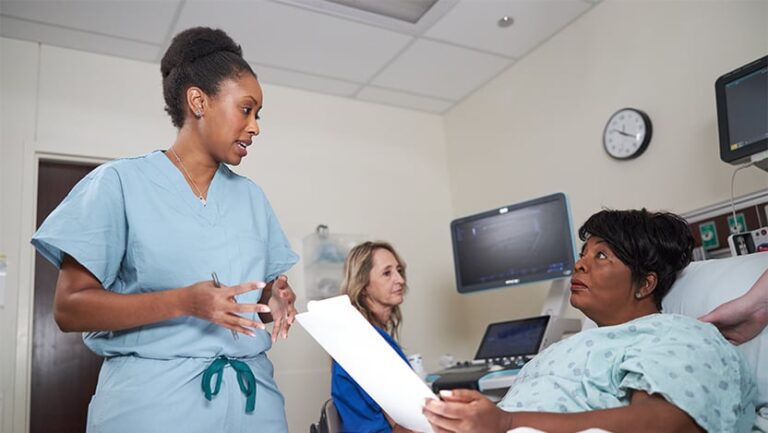Surgeon Chelsea Dorsey, MD, and team care for patients with a wide range of vascular conditions.
For patients with the condition, malfunctioning valves can cause blood to flow backwards and pool in the veins of the legs, which can lead to significant downstream effects for some people. Along with aching, throbbing, and tired legs, CVI patients may also develop varicose veins as well as discolored, infected, and ulcerated skin on their lower extremities.
Treatments such as laser ablation and sclerotherapy exist for superficial leg vein problems. But for patients with DVP, treatment is often limited to conservative measures, such as wearing compression stockings, elevating the legs, maintaining a healthy weight, and topical wound care for hard-to-heal skin ulcers.
“For many patients, especially those who must be on their feet for long periods of time for work or caregiving, it can be quite debilitating,” said vascular surgeon Chelsea Dorsey, MD, Director of the University of Chicago Clinic of Vein Medicine. “It can really affect someone’s ability to get through the day, especially if patients develop hard-to-heal skin wounds that can take weeks, months or even years to heal.”
The University of Chicago Medicine is participating in a clinical trial that will determine the safety and effectiveness of a new bioprosthetic valve for patients with severe deep vein CVI. UChicago Medicine is currently the only institution in Illinois participating in the study, which includes nearly two dozen centers across the United States. Dorsey successfully operated on the study’s first patient in Illinois in August.
“It’s been literally decades that I haven’t really had treatment options for this patient population, so to have a potential alternative for patients is something I haven’t seen in my career,” said Dorsey, who hopes to enroll at least five UChicago Medicine patients in the trial.
The walls of the veins are usually lined with paired flaps called valves that open in one direction to help blood flow out of the leg and into the heart. these valves close intermittently to prevent blood from flowing backwards. In people with CVI, the valves are damaged, causing blood to pool in the legs causing pain, swelling, discoloration and persistent ulcers.
Blood clots or deep vein thrombosis is a condition that can increase the risk of CVI. Blood clots can scar the inner wall of the veins and the function of the impingement valve. Being overweight, multiple pregnancies and being on your feet for long hours can also increase your risk of CVI, as can a family history of varicose veins and varicose veins. CVI is also more common in women and occurs more often as people age.
The Surgical Anti-reflux Venous Valve Endoprosthesis (SAVVE) The clinical trial is focused on adults with severe deep venous insufficiency – patients who are likely to already have significant swelling, skin changes, discoloration or ulcers.
The device is called the VenoValve and consists of a pig’s aortic valve – the same tissue used in some heart valve replacements – sewn onto a metal scaffold about an inch long.
The procedure begins with an incision in the inner thigh to access the femoral vein. An incision is made in the vein to implant the bioprosthetic device and sutures are used to secure it in place and close the vein and skin.
The doctor then uses a Doppler probe or ultrasound to make sure that the blood in the femoral vein is flowing properly and that the valve is opening and closing.
The implant is relatively simple but not without risk, Doresy said. In addition to the usual risks of surgery, such as bleeding and infection, there is a small chance that the device will embolize, stop working, or develop a clot around it.
A 2020 first-in-human study found no safety issues related to the device, and all 11 trial participants reported a significant reduction in pain six months after surgery. In August 2021, the FDA designated the VenoValve a breakthrough device. This designation helps manufacturers of certain promising medical devices efficiently navigate the FDA approval process.
“Essentially, we’re putting a functional valve back into one of the major veins of the leg to help get that blood up and out of the lower extremity,” Dorsey said. “It’s exciting to be involved in a trial for a new device with the potential to really solve the problem, reduce patients’ pain and return them to an active life. We are obviously in the early stages of understanding the impact of this process, but the idea of potentially helping millions of patients is exciting.”


